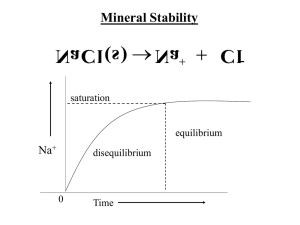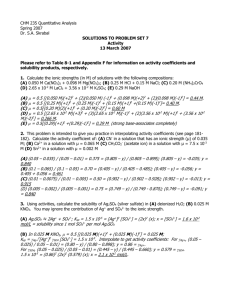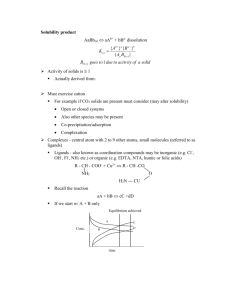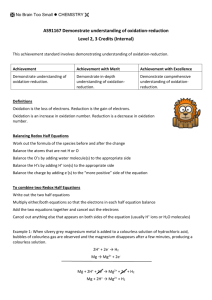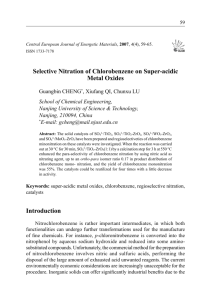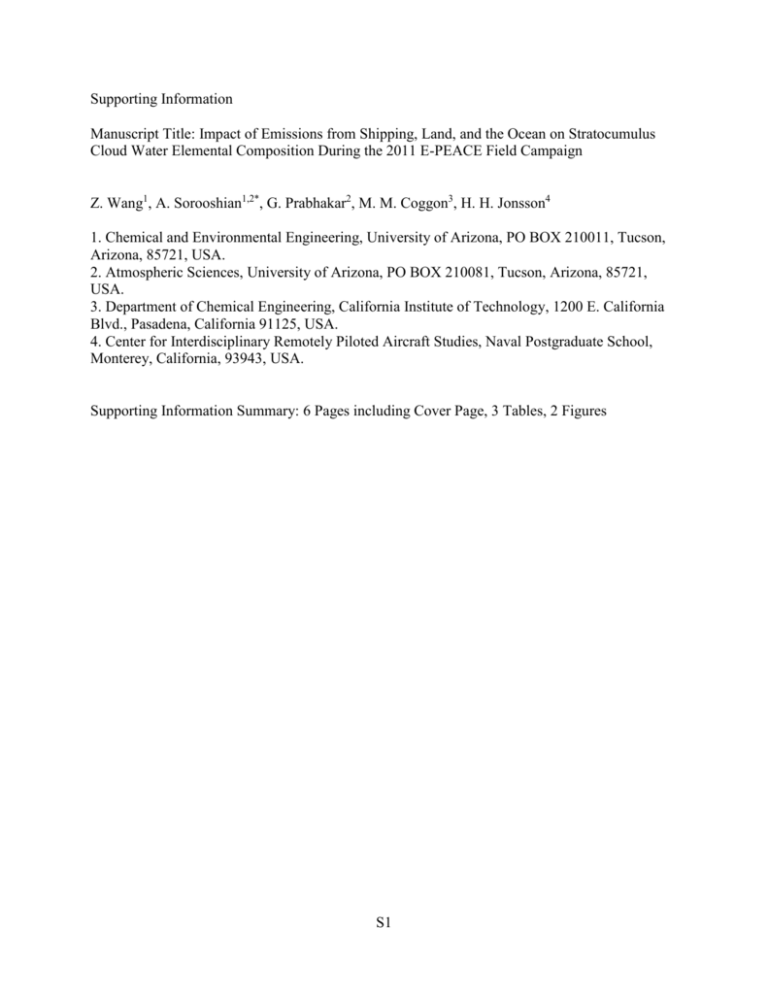
Supporting Information
Manuscript Title: Impact of Emissions from Shipping, Land, and the Ocean on Stratocumulus
Cloud Water Elemental Composition During the 2011 E-PEACE Field Campaign
Z. Wang1, A. Sorooshian1,2*, G. Prabhakar2, M. M. Coggon3, H. H. Jonsson4
1. Chemical and Environmental Engineering, University of Arizona, PO BOX 210011, Tucson,
Arizona, 85721, USA.
2. Atmospheric Sciences, University of Arizona, PO BOX 210081, Tucson, Arizona, 85721,
USA.
3. Department of Chemical Engineering, California Institute of Technology, 1200 E. California
Blvd., Pasadena, California 91125, USA.
4. Center for Interdisciplinary Remotely Piloted Aircraft Studies, Naval Postgraduate School,
Monterey, California, 93943, USA.
Supporting Information Summary: 6 Pages including Cover Page, 3 Tables, 2 Figures
S1
Table S1. Summary of sub-cloud (CPC, PCASP, wind speed, C-ToF-AMS aerosol composition)
and other cloud properties (base, top, depth, LWC) coinciding with collected cloud water
samples. C-ToF-AMS species concentrations are in units of µg m-3. σ refers to standard
deviation.
Sub-cloud
Sample Cloud Cloud Cloud Cloud
Sub-cloud
Sub-cloud
PCASP
Altitude Base Top Depth LWC
CPC (cm-3)
wind (m s -1)
-3
-3
(m)
(m)
(m)
(m) (g m )
(cm )
Ave 453
225
587
362
0.22
1192
285
6.78
s
142
115
131
115
0.10
1234
131
3.46
Min 124
73
224
95
0.07
184
39
1.20
Max 805
643
970
554
0.50
7143
598
12.10
S2
AMS AMS AMS AMS AMS
Org SO42- NH4+ NO3- Cl1.80
3.30
0.37
21.41
1.23
0.82
0.18
4.21
0.34
0.08
0.17
0.55
0.05
0.02
0.03
0.12
0.09
0.02
0.05
0.13
S3
-Cl
Na
-Rb
-Mg
--BrSr
-K
-Ca
-MSA
-Wind -0.37
-
-----------
-----------
--------0.51 0.36
------0.34 0.45
---
-----------
------ -0.26 -- 0.62 0.29
------ -0.25 -- 0.68 0.31
------- 0.36 0.65 0.41
------ -0.25 -- 0.68 0.31
-------- 0.54 0.42
------ -0.24 -- 0.67 0.34
-------- 0.68 0.30
-------- 0.70 0.46
----- 0.37
-- 0.36 0.64 0.45
-0.39 -0.42 -0.35 -0.37 -0.28 -0.38 --- -0.25
Si
B
Cs NO2- FTi
Al
Fe
Ba
Mn NO3- V
Pb Se
I
Si
1.00
B
0.54 1.00
Cs
0.65 0.97 1.00
---- 1.00
NO2
F---- 0.82 1.00
Ti
------ 1.00
Al
0.77 --- 0.34 0.42 -- 1.00
Fe
0.74 ----- 0.44 0.85 1.00
Ba
0.68 ----- 0.49 0.84 0.94 1.00
Mn 0.65 ---- 0.33 0.35 0.86 0.94 0.95 1.00
----- 0.57 0.74 0.62 0.64 1.00
NO3- 0.34 -V
------- 0.45 0.61 0.54 0.53 0.84 1.00
Pb
0.35 ---- 0.54 -- 0.37 0.38
-- 0.35
--- 1.00
Se
------------- 0.40 1.00
I
0.62 ------ 0.80 0.84 0.78 0.81 0.71 0.47 -- 0.47 1.00
2
-- 0.27 --- 0.55 0.69 0.61 0.61 0.87 0.69 --- 0.79
SO4 - 0.31 -0.43
0.34
0.41
0.35
0.53
0.38
0.38
0.44
0.63
--
1.00
SO42-
1.00
0.98
0.90
0.98
0.81
0.98
0.97
0.95
0.76
0.35
Cl-
1.00
0.91
1.00
0.75
1.00
0.99
0.98
0.74
0.38
Na
1.00
0.91
0.69
0.92
0.94
0.93
0.72
0.32
Rb
1.00
0.75
1.00
0.98
0.98
0.74
0.38
Mg
1.00
0.76
0.77
0.74
0.79
0.27
Br-
1.00
0.99
0.98
0.74
0.35
Sr
Ca MSA Wind
1.00
0.97 1.00
0.75 0.74 1.00
0.29 0.30 -- 1.00
K
Table S2. Correlation matrix for constituents in E-PEACE cloud water samples. Values shown
coincide with statistical significance using a two-tailed Student’s T-Test at 95% confidence.
Wind” corresponds to sub-cloud wind speed and SO42- is NSS SO42-.
Multiple Linear Regression Analysis Description
In this study, we conducted a multiple linear regression analysis to identify the
contribution of four major sources to total cloud water sulfate concentrations: “anthropogenic”,
“sea salt”, “marine biogenic”, and “continental crustal”. The chosen tracers are based on both
results from previous studies (Savoie et al., 1994; Johansen et al., 1999; Savoie et al., 2002) and
our study region characteristics. This analysis assumes that NSS SO42- (i.e. Total SO42- - sea salt
SO42-) can be represented as follows:
NSS SO42- = marine biogenic SO42- + anthropogenic SO42- + continental crustal SO42-
(1)
Key assumptions in the calculations of the Total SO42- components are shown in Table S3.
Table S3. Summary of components, tracers, and assumptions in the multiple linear regression
analysis. Na and Ca were measured by ICP-MS and we assume that they are fully soluble
(Coggon et al., 2012).
Component
SS SO42C. Crustal
SO42-
Tracers
Na
Assumptions
Sea water ratio: SS SO42-/Na = 0.252 (Saltzman et al., 1983)
NSS Ca
NSS Ca is from CaSO4
NSS Ca = Total Ca - Na × 0.038 based on sea water ratio (Seinfeld
and Pandis, 2006)
M. Biogenic
SO42
MSA
Anthropogenic
SO42-
NO3-
2+
Marine biogenic emissions solely from DMS with MSA and SO42- as
main products
Main source is ship emissions and NO3- is a key ship exhaust tracer in
this region (Coggon et al., 2012)
We conducted multiple linear regression analysis using Total SO42- as the dependent
variable and the four components of Total SO42- as independent variables. Details of this method
can be found in Zar (2010). The output partial regression coefficient for each component, which
is multiplied by each component concentration, is taken as the weighting factor representing the
amount by which Total SO42- is related to that component. The output equation of the analysis is
as follows with r2 = 0.99, n = 71, F = 1134.786, Fc (significance) = 0.000:
Total SO42- = 0.25 (± 0.02) Na + 6.56 (± 1.03) MSA + 0.87 (± 0.06) NO3- + 3.07 (± 1.50) NSS
Ca
(2)
The average contribution of the four sub-components to Total SO42- are calculated by doing the
following: (i) compute cumulative average concentration of the four tracer species (Na, MSA,
NO3-, and NSS Ca) and Total SO42-; (ii) multiply these concentrations by the coefficients above
except for Total SO42-; (iii) divide the concentration of each of the four sub-components by Total
SO42-. The result is that the most important contributors in decreasing order are “anthropogenic”
(37%), “sea salt” (32%), “marine biogenic” (26%), and “continental crustal” (6%).
S4
Figure S1. Three-day HYSPLIT back-trajectories of sampled air masses during E-PEACE. A
total of 82 trajectories are shown that end at the average position of where each cloud water
sample was collected. The orange box shows the spatial extent of the flights. The color-coding
reflects whether the air masses were most influenced by ship traffic, continental pollution, or
without continental or fresh ship emissions influence (termed “Marine Reference), which is not
necessarily pristine but most likely affected by aged ship emissions.
S5
Figure S2. Spatial distribution of MSA, Rb, and Cs (continuation of Figures 3 and 5).
References
Coggon, M. M., et al., 2012. Ship impacts on the marine atmosphere: insights into the
contribution of shipping emissions to the properties of marine aerosol and clouds. Atmospheric
Chemistry and Physics 12, 8439–8458.
Johansen, A.M., Siefert, R.L., Hoffmann, M.R., 1999. Chemical characterization of ambient
aerosol collected during the southwest monsoon and intermonsoon seasons over the Arabian Sea:
Anions and cations. Journal of Geophysical Research 104, 26325-26347.
Saltzman, E.S., Savoie, D.L., Zika, R.G., Prospero, J.M., 1983. Methane sulfonic-acid in the
marine atmosphere. Journal of Geophysical Research 88, 897-902.
Savoie, D.L., Prospero, J.M., Arimoto, R., Duce, R.A., 1994. Non-sea-salt sulfate and
methanesulfonate at American-Samoa. Journal of Geophysical Research 99, 3587-3596.
Savoie, D.L., Arimoto, R., Keene, W.C., Prospero, J.M., Duce, R.A., Galloway, J.N., 2002.
Marine biogenic and anthropogenic contributions to non-sea-salt sulfate in the marine boundary
layer over the North Atlantic Ocean. Journal of Geophysical Research 107(D18), 4356,
doi:10.1029/2001JD000970.
Seinfeld, J.H., and Pandis, S.N., 2006. Atmospheric Chemistry and Physics, Second Edition,
Wiley-Interscience, New York.
Zar, J. H., 2010. Biostatistical Analysis. 5th Edition. Pearson Prentice-Hall, Upper Saddle River,
NJ. 944 pp.
S6

